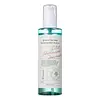What's inside
What's inside
 Key Ingredients
Key Ingredients

 Benefits
Benefits

 Concerns
Concerns

 Ingredients Side-by-side
Ingredients Side-by-side

Water
Skin ConditioningGlycerin
HumectantSodium C14-16 Olefin Sulfonate
CleansingCoco-Betaine
CleansingSorbitol
HumectantButylene Glycol
HumectantPotassium Benzoate
PreservativeEthylhexylglycerin
Skin ConditioningSodium Chloride
MaskingPropanediol
SolventCitric Acid
BufferingCoco-Glucoside
CleansingPanthenol
Skin ConditioningAcrylates Copolymer
Polyquaternium-10
Polyglyceryl-4 Caprate
EmulsifyingPolyglyceryl-6 Caprylate
EmulsifyingDecyl Glucoside
CleansingMusa Sapientum Fruit Extract
Skin ConditioningHydrangea Macrophylla Leaf Extract
Skin ConditioningHedera Helix Leaf/Stem Extract
AntimicrobialTheobroma Cacao Extract
Skin ConditioningTrisodium Ethylenediamine Disuccinate
Cocos Nucifera Oil
MaskingFragaria Chiloensis Fruit Extract
Skin Conditioning1,2-Hexanediol
Skin ConditioningGardenia Florida Flower Extract
Skin ConditioningHyaluronic Acid
HumectantHydrolyzed Hyaluronic Acid
HumectantSodium Hyaluronate
HumectantAmyris Balsamifera Bark Oil
MaskingOsmanthus Fragrans Flower Extract
MaskingDipotassium Phosphate
BufferingAcetyl Glutamine
Skin ConditioningCellulose Gum
Emulsion StabilisingWater, Glycerin, Sodium C14-16 Olefin Sulfonate, Coco-Betaine, Sorbitol, Butylene Glycol, Potassium Benzoate, Ethylhexylglycerin, Sodium Chloride, Propanediol, Citric Acid, Coco-Glucoside, Panthenol, Acrylates Copolymer, Polyquaternium-10, Polyglyceryl-4 Caprate, Polyglyceryl-6 Caprylate, Decyl Glucoside, Musa Sapientum Fruit Extract, Hydrangea Macrophylla Leaf Extract, Hedera Helix Leaf/Stem Extract, Theobroma Cacao Extract, Trisodium Ethylenediamine Disuccinate, Cocos Nucifera Oil, Fragaria Chiloensis Fruit Extract, 1,2-Hexanediol, Gardenia Florida Flower Extract, Hyaluronic Acid, Hydrolyzed Hyaluronic Acid, Sodium Hyaluronate, Amyris Balsamifera Bark Oil, Osmanthus Fragrans Flower Extract, Dipotassium Phosphate, Acetyl Glutamine, Cellulose Gum
Water
Skin ConditioningDecyl Glucoside
CleansingSodium Cocoyl Glutamate
CleansingChenopodium Quinoa Seed Extract
Skin ConditioningGlycerin
HumectantSodium Lauroyl Glutamate
Betaine
HumectantGlycine Soja Oil
EmollientMelaleuca Alternifolia Leaf Extract
PerfumingChlorphenesin
AntimicrobialHydroxyacetophenone
AntioxidantEthylhexylglycerin
Skin ConditioningCamellia Sinensis Leaf Extract
AntimicrobialHumulus Lupulus Extract
AntimicrobialOcimum Tenuiflorum Extract
Skin ConditioningCentella Asiatica Extract
CleansingCalendula Officinalis Flower Extract
MaskingPrunus Amygdalus Dulcis Fruit Extract
Skin ConditioningCitric Acid
BufferingGeranium Maculatum Oil
MaskingAllantoin
Skin ConditioningWater, Decyl Glucoside, Sodium Cocoyl Glutamate, Chenopodium Quinoa Seed Extract, Glycerin, Sodium Lauroyl Glutamate, Betaine, Glycine Soja Oil, Melaleuca Alternifolia Leaf Extract, Chlorphenesin, Hydroxyacetophenone, Ethylhexylglycerin, Camellia Sinensis Leaf Extract, Humulus Lupulus Extract, Ocimum Tenuiflorum Extract, Centella Asiatica Extract, Calendula Officinalis Flower Extract, Prunus Amygdalus Dulcis Fruit Extract, Citric Acid, Geranium Maculatum Oil, Allantoin
 Reviews
Reviews

Ingredients Explained
These ingredients are found in both products.
Ingredients higher up in an ingredient list are typically present in a larger amount.
Citric Acid is an alpha hydroxy acid (AHA) naturally found in citrus fruits like oranges, lemons, and limes.
Like other AHAs, citric acid can exfoliate skin by breaking down the bonds that hold dead skin cells together. This helps reveal smoother and brighter skin underneath.
However, this exfoliating effect only happens at high concentrations (20%) which can be hard to find in cosmetic products.
Due to this, citric acid is usually included in small amounts as a pH adjuster. This helps keep products slightly more acidic and compatible with skin's natural pH.
In skincare formulas, citric acid can:
While it can provide some skin benefits, research shows lactic acid and glycolic acid are generally more effective and less irritating exfoliants.
Most citric acid used in skincare today is made by fermenting sugars (usually from molasses). This synthetic version is identical to the natural citrus form but easier to stabilize and use in formulations.
Read more about some other popular AHA's here:
Learn more about Citric AcidDecyl Glucoside is a glucose-based surfactant and emulsion stabilizer. It is created by reacting glucose with the fatty acids from plants.
Surfactants help clean the skin by trapping oil, sebum, and dirt to be washed away. As an emulsion stabilizer, it stabilizes the ingredients in a product by preventing them from separating.
This ingredient is biodegradable and non-toxic. This ingredient is commonly found in baby shampoos.
Decyl Glucoside is sometimes used to stabilize the UV filter Tinosorb.
Learn more about Decyl GlucosideEthylhexylglycerin (we can't pronounce this either) is commonly used as a preservative and skin softener. It is derived from glyceryl.
You might see Ethylhexylglycerin often paired with other preservatives such as phenoxyethanol. Ethylhexylglycerin has been found to increase the effectiveness of these other preservatives.
Glycerin is already naturally found in your skin. It helps moisturize and protect your skin.
A study from 2016 found glycerin to be more effective as a humectant than AHAs and hyaluronic acid.
As a humectant, it helps the skin stay hydrated by pulling moisture to your skin. The low molecular weight of glycerin allows it to pull moisture into the deeper layers of your skin.
Hydrated skin improves your skin barrier; Your skin barrier helps protect against irritants and bacteria.
Glycerin has also been found to have antimicrobial and antiviral properties. Due to these properties, glycerin is often used in wound and burn treatments.
In cosmetics, glycerin is usually derived from plants such as soybean or palm. However, it can also be sourced from animals, such as tallow or animal fat.
This ingredient is organic, colorless, odorless, and non-toxic.
Glycerin is the name for this ingredient in American English. British English uses Glycerol/Glycerine.
Learn more about GlycerinWater. It's the most common cosmetic ingredient of all. You'll usually see it at the top of ingredient lists, meaning that it makes up the largest part of the product.
So why is it so popular? Water most often acts as a solvent - this means that it helps dissolve other ingredients into the formulation.
You'll also recognize water as that liquid we all need to stay alive. If you see this, drink a glass of water. Stay hydrated!
Learn more about Water